(word完整版)人教版七年级英语下册第四单元教案
- 格式:doc
- 大小:422.01 KB
- 文档页数:9
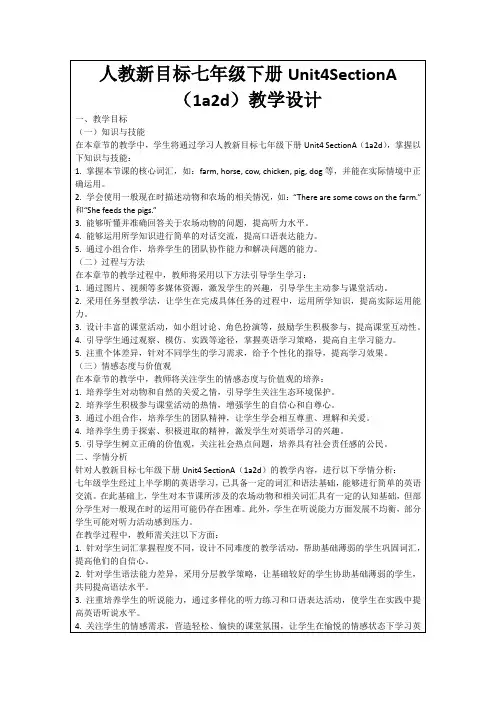
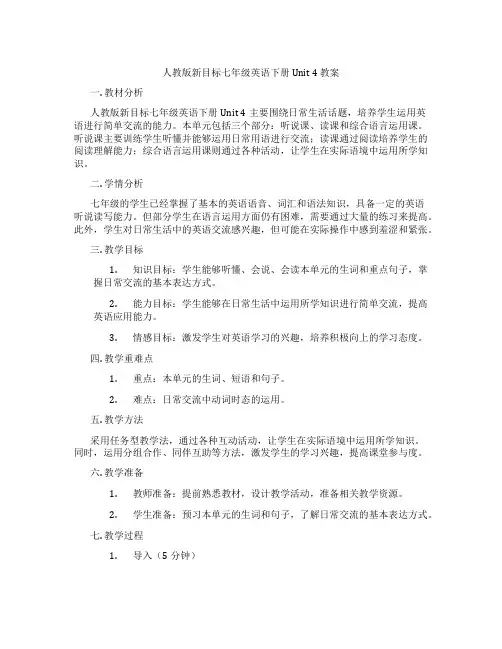
人教版新目标七年级英语下册 Unit 4 教案一. 教材分析人教版新目标七年级英语下册Unit 4主要围绕日常生活话题,培养学生运用英语进行简单交流的能力。
本单元包括三个部分:听说课、读课和综合语言运用课。
听说课主要训练学生听懂并能够运用日常用语进行交流;读课通过阅读培养学生的阅读理解能力;综合语言运用课则通过各种活动,让学生在实际语境中运用所学知识。
二. 学情分析七年级的学生已经掌握了基本的英语语音、词汇和语法知识,具备一定的英语听说读写能力。
但部分学生在语言运用方面仍有困难,需要通过大量的练习来提高。
此外,学生对日常生活中的英语交流感兴趣,但可能在实际操作中感到羞涩和紧张。
三. 教学目标1.知识目标:学生能够听懂、会说、会读本单元的生词和重点句子,掌握日常交流的基本表达方式。
2.能力目标:学生能够在日常生活中运用所学知识进行简单交流,提高英语应用能力。
3.情感目标:激发学生对英语学习的兴趣,培养积极向上的学习态度。
四. 教学重难点1.重点:本单元的生词、短语和句子。
2.难点:日常交流中动词时态的运用。
五. 教学方法采用任务型教学法,通过各种互动活动,让学生在实际语境中运用所学知识。
同时,运用分组合作、同伴互助等方法,激发学生的学习兴趣,提高课堂参与度。
六. 教学准备1.教师准备:提前熟悉教材,设计教学活动,准备相关教学资源。
2.学生准备:预习本单元的生词和句子,了解日常交流的基本表达方式。
七. 教学过程1.导入(5分钟)利用图片或实物引导学生谈论日常生活中的人物和事物,激发学生的学习兴趣。
2.呈现(10分钟)教师展示本课的生词和句子,让学生听懂并跟读。
同时,通过情景剧等形式,展示日常交流的基本表达方式。
3.操练(10分钟)学生分组进行角色扮演,模拟日常生活中的场景,运用所学知识进行交流。
教师巡回指导,纠正发音和语法错误。
4.巩固(5分钟)教师设计一些练习题,让学生口头回答,巩固所学知识。
5.拓展(5分钟)学生分组讨论,尝试用英语编写一个小故事,运用本课所学词汇和句型。
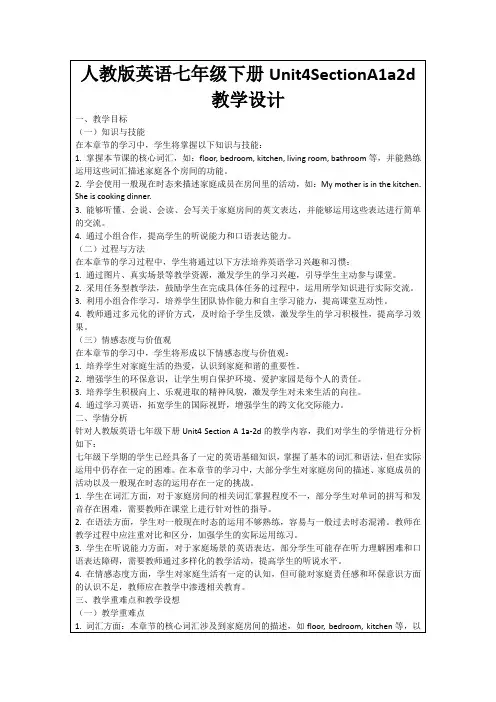
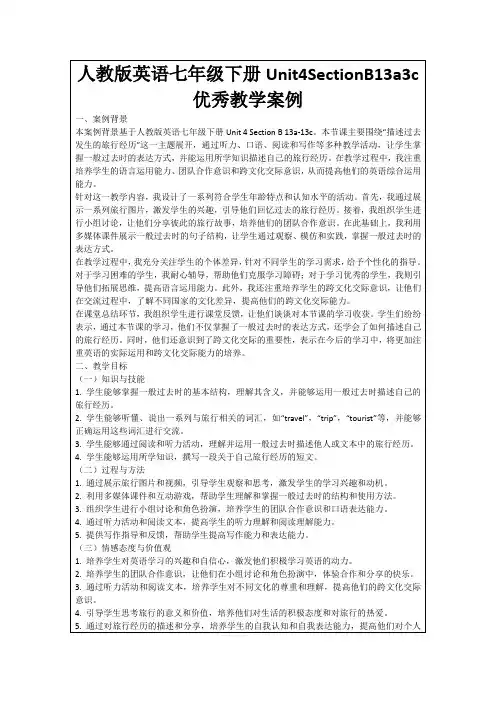
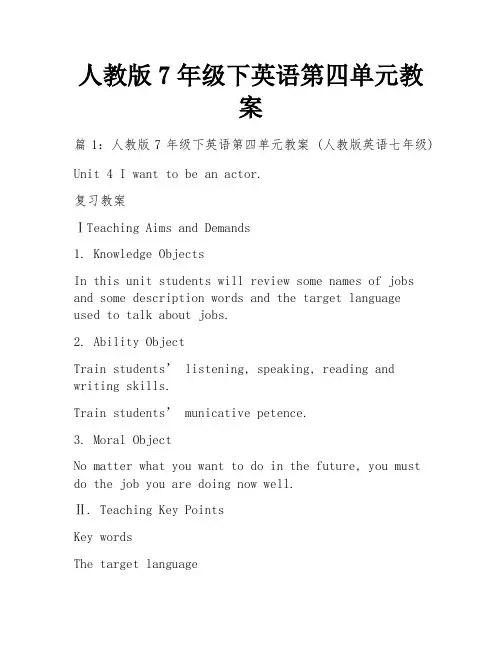
人教版7年级下英语第四单元教案篇1:人教版7年级下英语第四单元教案 (人教版英语七年级) Unit 4 I want to be an actor.复习教案ⅠTeaching Aims and Demands1. Knowledge ObjectsIn this unit students will review some names of jobs and some description words and the target language used to talk about jobs.2. Ability ObjectTrain students’ listening, speaking, reading and writing skills.Train students’ municative petence.3. Moral ObjectNo matter what you want to do in the future, you must do the job you are doing now well.Ⅱ. Teaching Key PointsKey wordsThe target languageReview how to talk about and describe jobs.Review the present tense.Review What and Where questions.Ⅲ. Teaching DifficultiesTrain students’ listening, speaking, reading and writing skills..Review how to read and write a newspaper want ad.Review how to write a letter applying for a job.Ⅳ. Teaching MethodsPairworkPracticing methodsⅤ. Teaching AidsA puterCardsⅥ. Teaching ProceduresStepⅠ ad1. In this activity you’re to write your own newspaper want ad.First you should decide what kind of job you can offer to people.Then consider what you are going to write about.2. Set a time limit of two or three minutes for students to prepare before writing the ad.3. Have students start to write their own newspaper want ads.4. Ask a student to write his or her ad on the blackboard. Correct any language and spelling errors along with the rest students.StepⅡ Pair work-talk about jobsUse these target language to make a conversation with your partner.What does he do?He’s a waiter.What do you want to be?I want to be an actor.Where does she work?She works in a bank.What does he do?He’s a student. He wants to be a doctor.StepⅢ Review the structures1. Review the where and what questions. Write sentences on your exercise book. Write as many as you can.2. Ask several students to read their sentences.StepⅣ Review the key vocabulary1. Give students several minutes to memorize the key vocabulary.Doctor, actor, reporter, police officer, waiter, band, clerk, sales assistant, student, dangerous, fun, exciting, difficult, boring, interesting2. Have a dictation.StepⅤ SummaryIn this class we’ve reviewed all the key words inthis unit .We also reviewed to write a newspaper want ad.StepⅥ HomeworkReview all the key words and language points learned in this unit.Blackboard DesignUnit 4 I want to be an actor.What does he do?He’s a waiter.What do you want to be?I want to be an actor.Where does she work?She works in a bank.教学反思:篇2:人教版七年级上英语第四单元复习资料be动词的种类:be动词包括“am”, “is”, “are”三种形式。
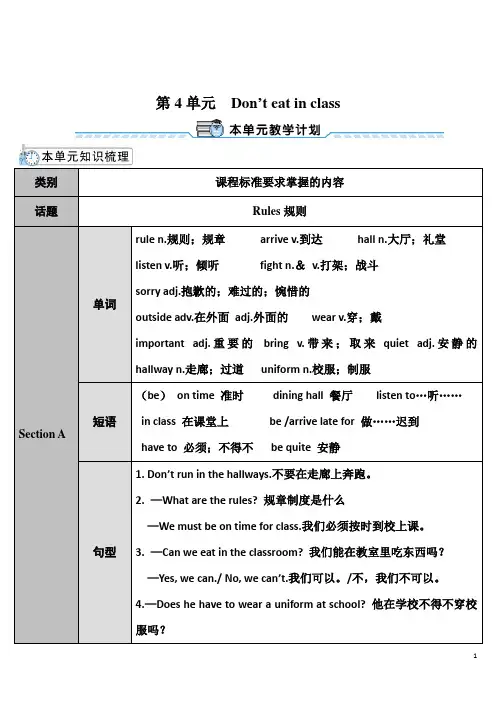
第4单元Do n’t eat in class类别课程标准要求掌握的内容话题Rules规则Section A 单词rule n.规则;规章arrive v.到达hall n.大厅;礼堂listen v.听;倾听fight n.&v.打架;战斗sorry adj.抱歉的;难过的;惋惜的outside adv.在外面adj.外面的wear v.穿;戴important adj.重要的bring v.带来;取来quiet adj.安静的hallway n.走廊;过道uniform n.校服;制服短语(be)on time 准时dining hall 餐厅listen to…听……in class 在课堂上be /arrive late for 做……迟到have to 必须;不得不be quite 安静句型1. Don’t run in the hallways.不要在走廊上奔跑。
2. —What are the rules? 规章制度是什么—We must be on time for class.我们必须按时到校上课。
3. —Can we eat in the classroom? 我们能在教室里吃东西吗?—Yes, we can./ No, we can’t.我们可以。
/不,我们不可以。
4.—Does he have to wear a uniform at school? 他在学校不得不穿校服吗?句型1. There are too many rules.有太多的规定。
2. I know how you feel.我知道你的感受。
3. I can’t relax on weekends either because I have to/must learn to play the piano.我周末也不能放松是因为我不得不/必须学习弹钢琴。
4. I think it’s best to follow the rules.我认为最好还是遵守规则。
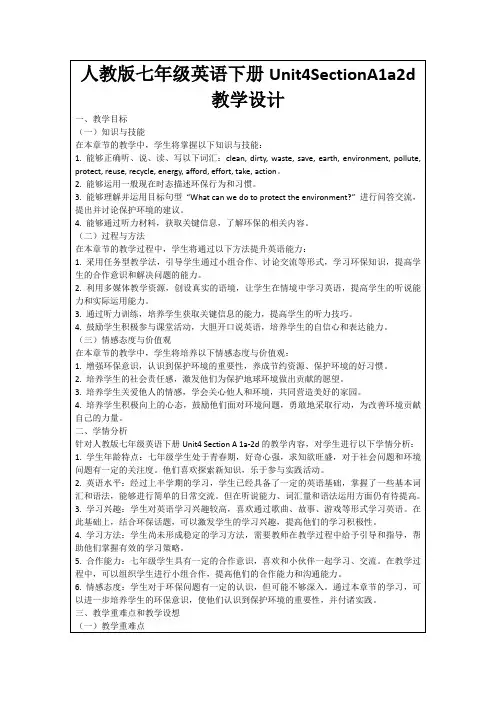
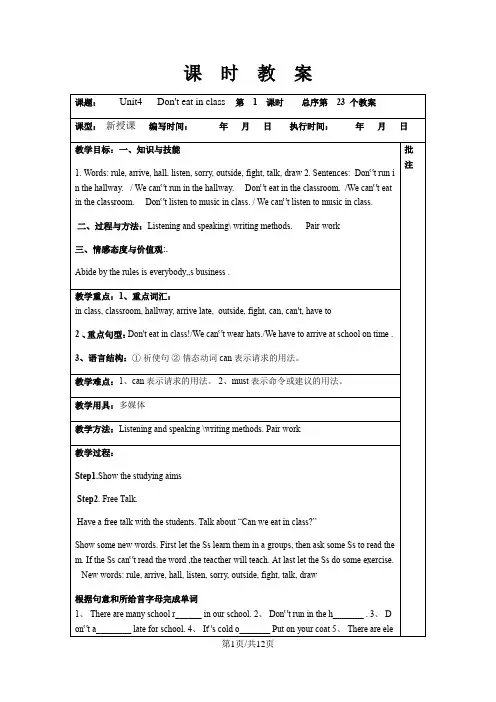
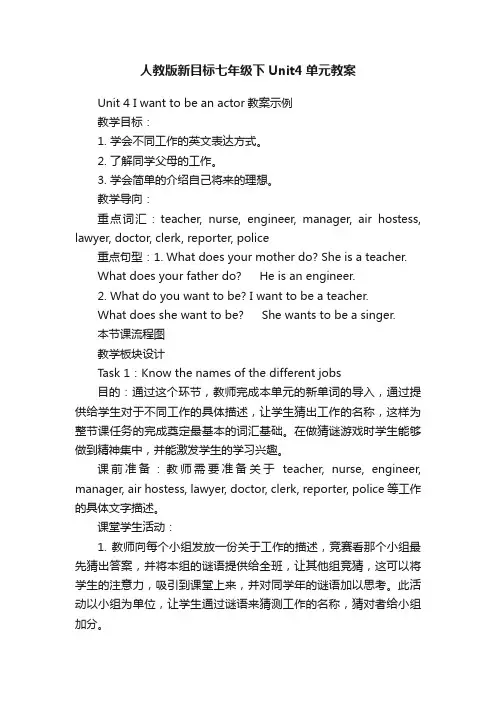
人教版新目标七年级下Unit4单元教案Unit 4 I want to be an actor教案示例教学目标:1. 学会不同工作的英文表达方式。
2. 了解同学父母的工作。
3. 学会简单的介绍自己将来的理想。
教学导向:重点词汇:teacher, nurse, engineer, manager, air hostess, lawyer, doctor, clerk, reporter, police重点句型:1. What does your mother do? She is a teacher.What does your father do? He is an engineer.2. What do you want to be? I want to be a teacher.What does she want to be? She wants to be a singer.本节课流程图教学板块设计Task 1:Know the names of the different jobs目的:通过这个环节,教师完成本单元的新单词的导入,通过提供给学生对于不同工作的具体描述,让学生猜出工作的名称,这样为整节课任务的完成奠定最基本的词汇基础。
在做猜谜游戏时学生能够做到精神集中,并能激发学生的学习兴趣。
课前准备:教师需要准备关于teacher, nurse, engineer, manager, air hostess, lawyer, doctor, clerk, reporter, police等工作的具体文字描述。
课堂学生活动:1. 教师向每个小组发放一份关于工作的描述,竞赛看那个小组最先猜出答案,并将本组的谜语提供给全班,让其他组竞猜,这可以将学生的注意力,吸引到课堂上来,并对同学年的谜语加以思考。
此活动以小组为单位,让学生通过谜语来猜测工作的名称,猜对者给小组加分。
The riddles supplied by the teacher:1) I work in the hospital every day. My work is very hard but also very important. The doctors and patients need my help. I help the doctor and look after the patients. I always wear white clothes. People call us “angels in white”.2) I drive a car every day, but the car is not mine. There are many people sitting in my car every day. After they go out of the car, they must pay me money.3) My job is very difficult but interesting. I help people on the court. If I succeed I will get lots of money, but if I fail, I get no money.4) I am very proud of my job. Because I am like your mother.I will tell you what is right and what is wrong. Sometimes I am very strict.5) I work outside; I am very busy because there are many letters in my bag, and I must give the letters to different people.6) I work in a restaurant and I always carry some fruits and dishes. I often ask people: What would you like? I am really very busy.2. 在所有单词导入后,以小组为单位,将所有单词按不同的标准分类,如:适合男人的工作,适合女人的工作等,通过这项活动,学生能将所学单词落到笔头上,同时是对所学单词的又一次巩固,而且不同的组有不同的分类原则,开发了同学无限的想象空间。
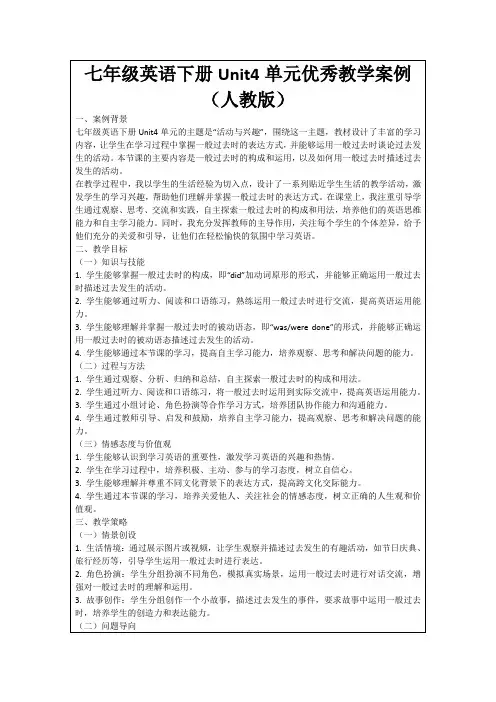
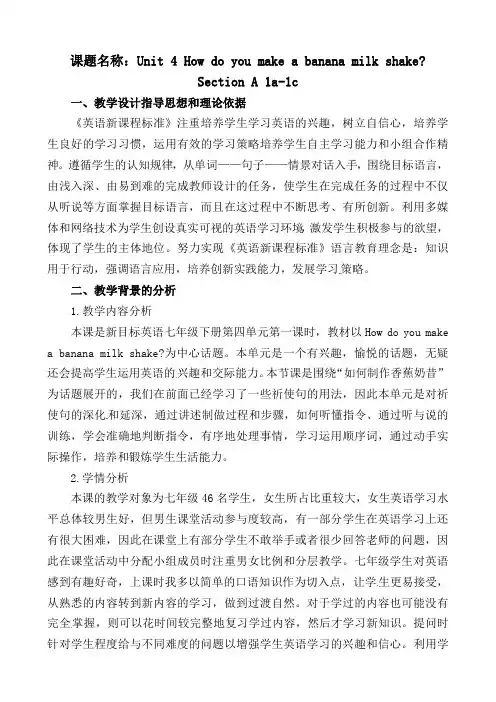
课题名称:Unit 4 How do you make a banana milk shake?Section A 1a-1c一、教学设计指导思想和理论依据《英语新课程标准》注重培养学生学习英语的兴趣,树立自信心,培养学生良好的学习习惯,运用有效的学习策略培养学生自主学习能力和小组合作精神。
遵循学生的认知规律,从单词——句子——情景对话入手,围绕目标语言,由浅入深、由易到难的完成教师设计的任务,使学生在完成任务的过程中不仅从听说等方面掌握目标语言,而且在这过程中不断思考、有所创新。
利用多媒体和网络技术为学生创设真实可视的英语学习环境,激发学生积极参与的欲望,体现了学生的主体地位。
努力实现《英语新课程标准》语言教育理念是:知识用于行动,强调语言应用,培养创新实践能力,发展学习策略。
二、教学背景的分析1.教学内容分析本课是新目标英语七年级下册第四单元第一课时,教材以How do you make a banana milk shake?为中心话题。
本单元是一个有兴趣,愉悦的话题,无疑还会提高学生运用英语的兴趣和交际能力。
本节课是围绕“如何制作香蕉奶昔”为话题展开的,我们在前面已经学习了一些祈使句的用法,因此本单元是对祈使句的深化和延深,通过讲述制做过程和步骤,如何听懂指令、通过听与说的训练,学会准确地判断指令,有序地处理事情,学习运用顺序词,通过动手实际操作,培养和锻炼学生生活能力。
2.学情分析本课的教学对象为七年级46名学生,女生所占比重较大,女生英语学习水平总体较男生好,但男生课堂活动参与度较高,有一部分学生在英语学习上还有很大困难,因此在课堂上有部分学生不敢举手或者很少回答老师的问题,因此在课堂活动中分配小组成员时注重男女比例和分层教学。
七年级学生对英语感到有趣好奇,上课时我多以简单的口语知识作为切入点,让学生更易接受,从熟悉的内容转到新内容的学习,做到过渡自然。
对于学过的内容也可能没有完全掌握,则可以花时间较完整地复习学过内容,然后才学习新知识。
Unit 4 : Don’t eat in class一.考点、热点回顾【重点单词】规则,规章__________ 到达____________ 带来,取来__________ 安静的_______________ 在…以前______________更多______________ 吵闹的______________ 感受,觉得___________ 严格的,严厉的______________ 记住,记起__________________ 幸运,运气___________ 保持,保留__________________【重点短语】上学迟到_____________ 按时__________ 听____________ 上课迟到_____________不得不______________ 太多____________ 好运_____________玩的开心_____________想让某人做某事__________________ 每天______________【重点句型】1.上课不到迟到__________ ___________ __________ for class.2.你必须准时You _____________ ____________ ____________ ____________.3.在课堂上不要听音乐__________ _________ __________ music in class.4.我们能把音乐播放器带到学校来吗?_________ we __________ music players ___________ school ?5.我们不必每天都来上学We don’t ___________ __________ come to school __________ __________.6.规则太多There are ___________ ______________ rules.7….我不想让猫抓住我… I don’t ____________ the cat __________ __________ me.【重点语法】【祈使句】祈使句是用来表示命令,请求或建议的一种句型。
UNIT 4Don ’teat in class.Section A第1课时(1a~1c)自主学习方案1.自学生词,并记着拼读及拼写。
2.预习课本找出要点短语及句子。
(见教案自学导练内容)3.读记后达成自学导练内容。
讲堂导学方案Step 1 情形导入Show the students the picture of fighting.T:Look at the two boys. What are they doing?Ss:(Help Ss) :They are fighting.T : Can we fight?Ss:No,we can't.T : What should we say to the boys?Ss:We should say to them: Don't fight.环节说明:经过师生对话引出新知识—祈使句。
Step 2 达成教材 1a_1c 的任务1.学习 la 中的学校规定,高声朗诵这些规定,而后将这些规定的序号填在相对应的人物旁边。
(3 分钟)2.认真听录音,找出Peter, Amy 和 Mike 违犯了哪些规定,在lb 中的横线上写出la中的数字,师生共同查对答案。
(2 分钟)3.再听一遍录音,同时跟读。
(2 分钟)4.练习 lc 中的对话。
而后编写新对话,小组内进行对话练习,并进行组与组之间的比赛,教师评论。
(5 分钟)5.小结训练。
(3 分钟)把以下祈使句改成否认形式。
(1)Eat in the hall.(2)Talk loudly.Don't eat in the hall. Don't talk loudly.环节说明:听闻联合,第一时间向学生传达语言目标,经过结对对话练习和小结训练,学生能够娴熟掌握祈使句。
Step3 问题研究1.arrive 的用法用arrive,arrive in/at 填空。
(1)When do you arrive in Shanghai every week?(2)When I arrive at Yucai Middle School in Shanghai,it is 7:50.(3)After I arrive here, I begin my class.【注意】 arrive“抵达”,arrive 是一个不及物动词,不可以直接跟表示地址的名词。
七年级Unit 4~ Unit 6 复习教学过程:(一)语言目标(Language Goal)1. 学会谈论自己和他人的职业。
Talk about jobs.2. 谈论自己和他人将来想从事的职业并陈述原因。
Talk about what you want to be.3. 谈论人们正在干什么。
Talk about what people are doing.4. 学习描述天气。
Describe the weather.(二)目标句型1. What does he / she do? He/ She is a doctor.2. What do you want to be? I want to be an actor.3. Where does she work? She works at a bank.4. Do you like to talk with people?5. How’s the weather? It’s raining.6. How’s it going? It’s great.7. Is Aunt Sarah there? Yes, she is.8. What’s she doing? She’s cooking.9. What are you doing? I’m watching TV.10. What’s he doing? He’s doing homework.11. Do you want to go swimming? Yes, I do.12. When do you want to go? At three o’clock.(三)语法1. 学习并熟练掌握一般现在时态的意义和主要使用方法。
2. 能够围绕“职业”这一话题,熟练使用动词“want, work”的一般现在时态进行实际交际。
3. 现在进行时Present progressive tense。
4. how引导的疑问句;How questions。
Unit4 Where’s my schoolbag ?第一课时Section(1a--2c)教师:周小绢Language Goal:Talk abou things around the house本单元主要内容是谈论物品的所在位置,通过这一话题,训练学生的听、说、读、写四项基本技能,让学生通过询问物品的位置,学习一些物品的单词,及方位介词 on , in , under ,behind 等的用法;使学生学会基本句型“Where’s +物品名词(单数)? It’s …”及“Where're+物品名词(复数)? They're …”,进一步体会“Where…? Yes/No”疑问句的用法;学会运用方位介词"on/in/under/behind/next to"表达物品的位置。
理解连词and在句子中的用法。
教学目标知识与能力(1)学习和掌握有关询问物品位置的句型:Where’s my schoolbag? It’s on/in/under the dest.(2)学习和掌握有关家具类的单词:table,bed,schoolbag,sofa,chair,schoolba...(3)学会三个方位介词的用法:on,in,under过程与方法利用教学图片来展开课堂Pair work 问答式的口语交际活动,使学生学会基本句型“Where’s my schoolbag ? ”It’s under the chair.及方位介词情感态度价值观这部分学习内容贴近学生的生活,谈论的主题是学生最关心的问题,促使学生了解自己的家居环境,热爱自己的家。
教学重点(1)方位介词:in, on,under的用法;(2).Where的特殊疑问句(3)新单词:chair,bed,table,bookcase,radio,sofa,head...教学难点1)能够准确运用方位介词描述物品所在的位置;2)能够运用Where问句找到物品的位置。
UNIT 4 Don’t eat in class.Section A 第1课时(1a~1c)自主学习方案1.自学生词,并记住拼读及拼写。
2.预习课本找出重点短语及句子。
(见学案自学导练内容)3.读记后完成自学导练内容。
课堂导学方案Step 1情景导入Show the students the picture of fighting.T:Look at the two boys. What are they doing?Ss:(Help Ss) :They are fighting.T :Can we fight?Ss:No,we can't.T :What should we say to the boys?Ss:We should say to them:Don't fight.环节说明:通过师生对话引出新知识—祈使句。
Step 2完成教材1a_1c的任务1.学习la中的学校规定,大声朗读这些规定,然后将这些规定的序号填在相对应的人物旁边。
(3分钟)2.认真听录音,找出Peter,Amy和Mike违反了哪些规定,在lb中的横线上写出la中的数字,师生共同核对答案。
(2分钟)3.再听一遍录音,同时跟读。
(2分钟)4.练习lc中的对话。
然后编写新对话,小组内进行对话练习,并进行组与组之间的比赛,教师点评。
(5分钟)5.小结训练。
(3分钟)把下列祈使句改成否定形式。
(1)Eat in the hall. Don't eat in the hall.(2)Talk loudly. Don't talk loudly.环节说明:听说结合,第一时间向学生传达语言目标,通过结对对话练习和小结训练,学生可以熟练掌握祈使句。
Step3问题探究1.arrive的用法用arrive,arrive in/at 填空。
(1)When do you arrive in Shanghai every week?(2)When I arrive at Yucai Middle School in Shanghai,it is 7:50.(3)After I arrive here,I begin my class.【注意】arrive“到达”,arrive是一个不及物动词,不能直接跟表示地点的名词。
如果要跟名词,就必须加介词in或at。
在“大地方”前加in;在“小地方”前加at。
如果arrive 后是地点副词,就不用介词。
2.我们学过的“到达”的另一种表达法是:get to。
下周上学不要迟到。
Don't be late for school next week.(1)打开门open the door(2)不要在教室里听音乐。
Don't listen to music in the classroom.【注意】祈使句的开头是动词原形。
祈使句的否定形式多以don't开头,再加上动词原形。
4.We must go to school A every day.A. on timeB. in timeC. for timeD. at time【注意】on time“准时”;in time “及时”。
Step 4 家庭作业完成课后提升作业(学案P. 22)。
教学反思Section A 第2课时(2a~3c)自主学习方案1.自学生词,并记住拼读及拼写。
2.预习课本找出重点短语及句子。
(见学案自学导练内容)3.读记后完成自学导练内容。
课堂导学方案Step 1情景导入Teacher:Our school is very big and beautiful,and there are a lot of rules helping us to study better. Can you tell me the rules in the school?环节说明:通过这个环节既复习了上节课学习的内容,又练习了学生的口语。
Step 2完成教材2a—2c的任务1.听录音,将Cindy和Alan所谈论的活动选出来完成2a,展示答案,教师点评。
(3分钟)2.听录音并根据要求完成题目2b,小组内核对答案,教师展示答案。
(3分钟)3.再听一遍录音,跟读并体会can,can't的用法。
(2分钟)4.两人一组,根据2a中的信息,仿照2c的形式来练习对话,并邀请几组学生表演对话。
(2分钟)5.小结训练。
(2分钟)用can和can't填空。
(1)Mr. Green can't smoke (吸烟)here,because there ’ s a sign on the wall. It says “No smoking”.(2)It,s very hot outside. You can wear a hat.Step 3完成教材2d的任务1.学生认真自读对话,根据对话内容完成下列句子。
(5分钟)(1)John,s new school has a lot of rules .(2)It’s important to be on time .(3)John can ’ t bring music players to school .(4)John always wears the school uniform to school and is quiet in the library.2.大声朗读2d对话,读熟后与同伴结对练习,分角色表演对话。
(分钟)环节说明:将对话转化成填空题,这样能对所学的重要句型起到复习巩固的作用。
S te p 4 完成Gramm e r Fo c us1.学生归纳。
2.师生参考学案p. 26的单元语法透析,并完成练习。
S te p 5 完成教材3a—3c的任务1.认真观察图片,用所学的祈使句句型为学校图书馆写一些规定,写完后小组内交流,教师抽查点评。
(2分钟)2.利用所给的单词或短语来组成关于学校规定的句子,然后根据学校的实际情况来回答。
请学生在黑板上展示答案。
(分钟)3.写五条理想学校的校规,然后和其他同学分享,选出最受欢迎的校规。
(3分钟)4.利用所选出的校规来写一篇小短文。
(5分钟)S te p 6问题探究must和have to的用法(1)你不得不穿校服吗?Do you have to wear the school uniform?(2)—我现在必须要走吗?—不,你不必。
—Must I go now?—No,you needn't .【注意】have/has to + 认原形:强调由客观原因造成的不得不去做……;must +v.原形:强调由主观要做……,must没有时态、人称和数的变化,must的否定回答为needn't。
S te p 7 家庭作业完成课后提升作业(学案p. 23)教学反思Section B 第3课时(1a~1d)自主学习方案1.自学生词,并记住拼读及拼写。
2.预习课本找出重点短语及句子。
(见学案自学导练内容)3.读记后完成自学导练内容。
课堂导学方案Step 1情景导入(2分钟)Show students a photo of Dave and tell the students:Dave has some school rules to follow at school. And at home,he also has rules. What are the rules at Dave’s home. Do you want to know?Let' learn together and you will find the answer.环节说明:通过设置悬念,引起学生的学习兴趣,导入本课的学习。
Step 2完成教材1a_1d的任务先让学生仔细看la中的图片,教师用句型“What is he/she doing?”提问。
然后指出这些制度,教师领读。
最后将lb中的短语和la中的图片匹配,并核对答案。
(5分钟)听录音,标出Dave不能做的事情和他必须要做的事情,集体核对答案,完成lb。
(2分钟)记忆lc中的短语,然后听录音,从lc中选出Dave遵守lb中这些规定的时间。
(5分钟)两人一组仿照ld的对话形式,结合实际谈论自己的家规。
最后请学生做简短的报告。
(5分钟)参考案例:5.小结训练。
(3分钟)(1)—Can you watch TV C dinner?—No,but I can do it after dinner.A. forB. afterC. beforeD. on(2)—Why are you w alking so fast?—Because I C get home to do my work.A. haveB. go toC. have toD. has to(3)—Can you cook dinner?— B . It’s easy.A. No,I can'tB. Yes,I canC. No,I canD. Yes,I need环节说明:本环节的学习使学生熟练地掌握情态动词can,can't和have to的用法,并且为谈论自己的家规奠定了基础。
Step3 问题探究1.practice 的用法练习吉他practice the guitar练习弹吉他practice playing the guitar【注意】practice意为“练习,实践”。
它的后面可以跟名词、代词或动词v-ing形式。
2.在上学期间的晚上on school nights【注意】night前若有其他词汇修饰,指具体的某个晚上,应用介词on。
3.help 的用法(1)帮助他们help them(2)帮助他们学英语help them with English(3)帮助他们洗餐具help them (to) do the dishes【注意】help sb. with sth.在……上帮助某人,help sb. (to) do sth.帮助某人干……Step 4 家庭作业完成课后提升作业(学案p. 24)。
教学反思Section B 第3课时(1a~1d)自主学习方案1.自学生词,并记住拼读及拼写。
2.预习课本找出重点短语及句子。
(见学案自学导练内容)3.读记后完成自学导练内容。
课堂导学方案Step1 情景导入Teacher:When you are unhappy about something,who do you like to talk to,your parents,your teachers or your friends?Can you tell me?Students:…Teacher:Molly is a student like us. She is very upset. Do you know why she is unhappy,and who she likes to talk to?环节说明:通过情景导入既完成了2a的学习又引出了Molly的烦恼,引起学生的好奇心,激发了他们的学习欲望。